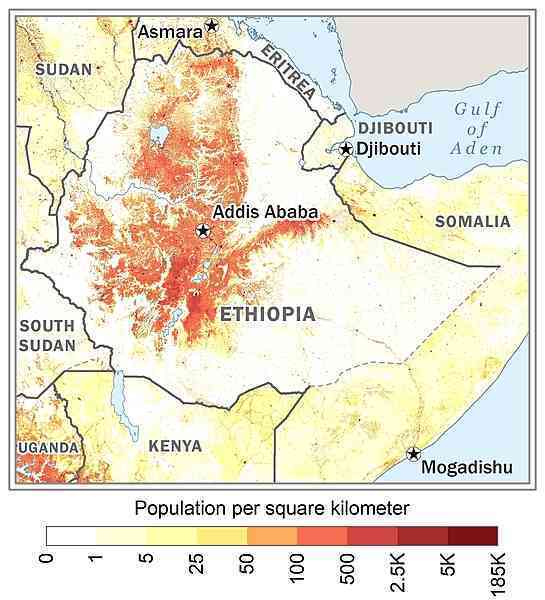
Eastern Africa, west of Somalia
8 00 N, 38 00 E
Africa
total: 1,104,300 sq km
land: 1,096,570 sq km
water: 7,730 sq km
note: area numbers are approximate since a large portion of the Ethiopia-Somalia border is undefined
slightly less than twice the size of Texas
total: 5,925 km
border countries (6): Djibouti 342 km; Eritrea 1,033 km; Kenya 867 km; Somalia 1,640 km; South Sudan 1,299 km; Sudan 744 km
0 km (landlocked)
none (landlocked)
tropical monsoon with wide topographic-induced variation
high plateau with central mountain range divided by Great Rift Valley
highest point: Ras Dejen 4,550 m
lowest point: Danakil Depression -125 m
mean elevation: 1,330 m
small reserves of gold, platinum, copper, potash, natural gas, hydropower
agricultural land: 36.3% (2018 est.)
arable land: 15.2% (2018 est.)
permanent crops: 1.1% (2018 est.)
permanent pasture: 20% (2018 est.)
forest: 12.2% (2018 est.)
other: 51.5% (2018 est.)
1,813 sq km (2020)
fresh water lake(s): Lake Tana - 3,600 sq km; Abaya Hayk - 1,160 sq km; Ch'amo Hayk - 550 sq km
salt water lake(s): Lake Turkana (shared with Kenya) - 6,400 sq km; Abhe Bid Hayk/Abhe Bad (shared with Djibouti) - 780 sq km;
Blue Nile river source (shared with Sudan [m]) - 1,600 km
note – [s] after country name indicates river source; [m] after country name indicates river mouth
Atlantic Ocean drainage: (Mediterranean Sea) Nile (3,254,853 sq km)
Ogaden-Juba Basin, Sudd Basin (Umm Ruwaba Aquifer)
highest density is found in the highlands of the north and middle areas of the country, particularly around the centrally located capital city of Addis Ababa; the far east and southeast are sparsely populated as shown in this 
geologically active Great Rift Valley susceptible to earthquakes, volcanic eruptions; frequent droughts
volcanism: volcanic activity in the Great Rift Valley; Erta Ale (613 m), which has caused frequent lava flows in recent years, is the country's most active volcano; Dabbahu became active in 2005, forcing evacuations; other historically active volcanoes include Alayta, Dalaffilla, Dallol, Dama Ali, Fentale, Kone, Manda Hararo, and Manda-Inakir
note 1: landlocked - entire coastline along the Red Sea was lost with the de jure independence of Eritrea on 24 May 1993; Ethiopia is, therefore, the most populous landlocked country in the world; the Blue Nile, the chief headstream of the Nile by water volume, rises in T'ana Hayk (Lake Tana) in northwest Ethiopia
note 2: three major crops may have originated in Ethiopia: coffee (almost certainly), grain sorghum, and castor bean
NOTE: The information regarding Ethiopia on this page is re-published from the 2024 World Fact Book of the United States Central Intelligence Agency and other sources. No claims are made regarding the accuracy of Ethiopia 2024 information contained here. All suggestions for corrections of any errors about Ethiopia 2024 should be addressed to the CIA or the source cited on each page.
This page was last modified 04 May 24, Copyright © 2024 ITA all rights reserved.